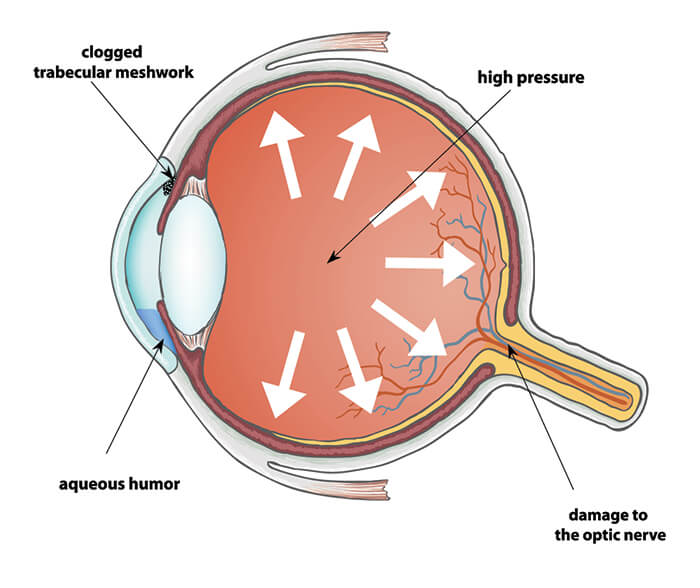What is glaucoma?
Glaucoma is a leading cause of blindness in the United States, especially for older people. But loss of sight from glaucoma is preventable if you get treatment early enough.
Glaucoma is a disease of the optic nerve. The optic nerve carries the images we see to the brain. Many people know that glaucoma has something to do with pressure inside the eye. The higher the pressure inside the eye, the greater the chance of damage to the optic nerve.
The optic nerve is like an electric cable containing a huge number of wires. Glaucoma can damage nerve fibers, causing blind spots to develop.
Often people don’t notice these blind areas until much optic nerve damage has already occurred. If the entire nerve is destroyed, vision loss results.
Early detection and treatment by your ophthalmologist are the keys to preventing optic nerve damage and vision loss from glaucoma.

What causes glaucoma?
Clear liquid, called the aqueous humor, flows in and out of the eye. The liquid is not part of the tears on the outer surface of the eye. You can think of the flow of aqueous fluid as a sink with the faucet turned on all the time.
If the “drainpipe” gets clogged, water collects in the sink and pressure builds up. If the drainage area of the eye-called the drainage angle—is blocked, the fluid pressure within the inner eye may increase, which can damage the optic nerve.
What are the different types of glaucoma?
Chronic open-angle glaucoma: This is the most common glaucoma. It occurs as a result of aging. The “drainpipe,” or drainage angle of the eye, becomes less efficient with time, and pressure within the eye gradually increases.
If this increased pressure results in optic nerve damage, it is known as chronic open-angle glaucoma. Over 90% of adult glaucoma patients have this type of glaucoma.
Chronic open-angle glaucoma can damage vision so gradually and painlessly that you are not aware of trouble until the optic nerve is already badly damaged.
Angle-closure glaucoma: Sometimes the drainage angle of the eye may become completely blocked.
It is as though a sheet of paper floating near a drain suddenly slips over the opening and blocks the flow out of the sink. In the eye, the iris may act like the sheet of paper closing off the drainage angle.
When eye pressure builds up rapidly, it is called acute angle-closure glaucoma.
The symptoms include:
- Blurred vision;
- Severe eye pain;
- Headache;
- Rainbow halos around lights;
- Nausea and vomiting.
If you have any of these symptoms, call your ophthalmologist immediately. Unless an ophthalmologist treats acute angle-closure glaucoma quickly, blindness can result.
A more gradual and painless closing of the angle is called chronic angle-closure glaucoma. It occurs more frequently in people of African and Asian ancestry.
How is glaucoma detected?
Regular eye examinations by your eye doctor are the best way to detect glaucoma.
During a complete and painless examination, your eye doctor will:
- Measure your intraocular pressure (tonometry)
- Inspect the drainage angle of your eye (gonioscopy)
- Evaluate any optic nerve damage (ophthalmoscopy)
- Test the vision of each eye
Some of these tests may not be necessary for every person. You may need to repeat these tests on a regular basis, to determine if glaucoma damage is increasing over time.
 Who is at risk for glaucoma?
Who is at risk for glaucoma?
High pressure alone does not mean that you have glaucoma. Your eye doctor puts together many kinds of information to determine your risk for developing the disease.
The most important risk factors include:
- Age;
- Near-sightedness;
- African ancestry;
- A family history of glaucoma;
- Past injuries to the eyes;
- A history of severe anemia or shock
Your eye doctor will weigh all of these factors before deciding whether you need treatment for glaucoma or whether you should be monitored closely as a glaucoma suspect.
This means your risk of developing glaucoma is higher than normal, and you need to have regular examinations to detect early signs of damage to the optic nerve.
